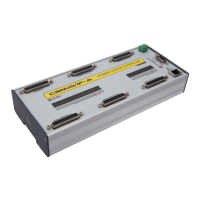11.2 PID controller terms (parameters) operation
There are like tens of thousands descriptions of PID controller work in the Internet, but for most of people
- putting it mildly - they are rather vague and actually do not say anything. In this section we present the
PID controller blocks described in a few words so you could get the logic of their operation.
11.2.1 The proportional term – P
It is the easiest part of the controller. It makes that correction is greater the larger position error is. The
error is calculated in the following way:
=
Where:
P
err
: position error
P : current, set position
P
enc
: actual position of an encoder
An output of the proportional term is calculated by the formula:
=
Where:
OUT
P
: output of proportional term
K
p
: Proportional gain
P
err
: Position error
Lets assume that the set position= 0, Kp = 10 and analyze the situation for a few different actual positions
of a motor:
• Motor position = 0: Error is zero, so the ‘P’ term has also zero output so there is no correction
(because it is not necessary).
• Motor position = 1: Error = (0 – 1) = -1. The output = 10 * -1 = -10.
• Motor position = 5: Error = (0 – 5) = -5. The output = 10 * -5 = -50.
• Motor position = -5: Error = (0 – (-5)) = 5. The output = 10 * 5 = 50.
As you can see above correction is greater the larger the error value is and direction of the correction is
opposite to the error direction. This part of the PID controller is effective at larger error values, for smaller
error values it is not doing very well.
11.2.2 The integral term – I
For some users unfamiliar with mathematics the integral may sounds scary, in fact the term operation is
very easy. An output of the integral term of PID controller depends on the position error and the duration
of the error. Lets assume that the Integral eliminated most of the position error, but there a small error left
due to friction e.g. 10 p. of an encoder. With so small error the Proportional control does not correct too
much and its output is not able to overcome the friction. SO the motor stands and the error remains. Here
we have the Integral term ‘I’. To simplify lets assume that the controller works once per second and Ki
(gain) = 1. In this situation ‘I’ output will look like this:
CS- Lab s.c. – CSMIO/IP- A - CNC controller
Page 78

